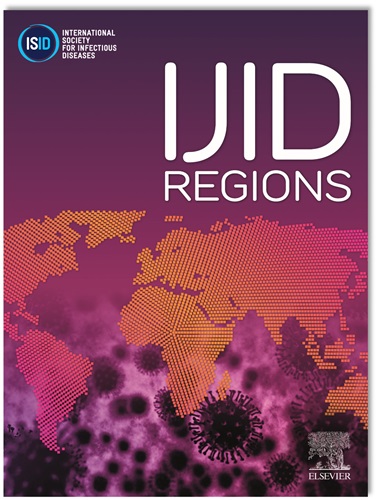Longitudinal epidemiology of pulmonary nontuberculous mycobacteria and tuberculosis in Singapore (2006-2024): Emerging dominance of Mycobacterium abscessus
IF 4.3
2区 医学
Q1 INFECTIOUS DISEASES
引用次数: 0
Abstract
Background
Nontuberculous mycobacteria (NTM) are increasingly recognized as important pulmonary pathogens, with rising incidence reported globally as tuberculosis (TB) declines. While epidemiology is well described in temperate regions, long-term data from tropical, high-density cities such as Singapore remain scarce. Prior local studies suggested a shift from Mycobacterium avium complex (MAC) to M. abscessus as the predominant NTM species, but comprehensive longitudinal analyses are lacking.
Methods
We performed a retrospective review of all respiratory mycobacterial cultures at Singapore General Hospital between 2006 and 2024. Pulmonary NTM (pNTM) was defined using 2007 ATS/IDSA microbiologic criteria (≥2 specimens with same species or one positive BAL/biopsy), and pulmonary TB (pTB) as a single culture-positive respiratory specimen. Only the first isolate per patient per species was included. ICD-10 coding data (2018–2024) were also analysed to verify trends.
Results
A total of 3877 pTB and 1825 pNTM cases met inclusion criteria. Incidence of pNTM increased from 35 to 65 per 100,000 patient-years, while pTB declined from 225 to 70 per 100,000 patient-years. ICD-10 coding data confirmed similar trends, with pTB incidence declining from 185 to 41 per 100,000 patient-years between 2018 and 2024, while pNTM remained stable at 40-43. Species distribution, derived from microbiological isolates, showed a steady decline in MAC and a marked rise in M. abscessus, which surpassed MAC as the most common species after 2014.
Conclusion
pNTM incidence has risen substantially in Singapore, now approaching that of TB. The emergence of M. abscessus as the predominant NTM species has important clinical and public health implications, underscoring the need for ongoing integrated surveillance and tailored management strategies in tropical urban environments.
新加坡肺部非结核分枝杆菌和结核病的纵向流行病学(2006 - 2024):脓肿分枝杆菌的新兴优势。
背景:非结核分枝杆菌(NTM)越来越被认为是重要的肺部病原体,随着结核病(TB)的下降,全球发病率上升。虽然在温带地区对流行病学有很好的描述,但来自热带高密度城市(如新加坡)的长期数据仍然很少。先前的当地研究表明,从鸟分枝杆菌复合体(MAC)到脓肿分枝杆菌(M. abesssus)是主要的NTM物种,但缺乏全面的纵向分析。方法:我们对2006年至2024年在新加坡总医院进行的所有呼吸道分枝杆菌培养进行回顾性分析。肺NTM (pNTM)的定义采用2007年ATS/IDSA微生物学标准(≥2个同种标本或1个BAL/活检阳性标本),肺结核(pTB)为单个培养阳性呼吸道标本。每个患者每个物种只包括第一个分离株。还分析了ICD-10编码数据(2018-2024)以验证趋势。结果:共有3877例pTB和1825例pNTM符合纳入标准。pNTM的发病率从每10万患者年35例增加到65例,而pTB的发病率从每10万患者年225例下降到70例。ICD-10编码数据证实了类似的趋势,2018-2024年期间,pTB发病率从每10万患者年185例下降到41例,而pNTM保持稳定在40-43例。从微生物分离株的物种分布来看,2014年以后,macs呈下降趋势,而M. abesssus呈上升趋势,超过macs成为最常见的物种。结论:pNTM在新加坡的发病率已大幅上升,目前已接近结核病的发病率。脓肿分枝杆菌作为主要NTM物种的出现具有重要的临床和公共卫生意义,强调需要在热带城市环境中进行持续的综合监测和量身定制的管理策略。
本文章由计算机程序翻译,如有差异,请以英文原文为准。
求助全文
约1分钟内获得全文
求助全文
来源期刊
CiteScore
18.90
自引率
2.40%
发文量
1020
审稿时长
30 days
期刊介绍:
International Journal of Infectious Diseases (IJID)
Publisher: International Society for Infectious Diseases
Publication Frequency: Monthly
Type: Peer-reviewed, Open Access
Scope:
Publishes original clinical and laboratory-based research.
Reports clinical trials, reviews, and some case reports.
Focuses on epidemiology, clinical diagnosis, treatment, and control of infectious diseases.
Emphasizes diseases common in under-resourced countries.

 求助内容:
求助内容: 应助结果提醒方式:
应助结果提醒方式:


